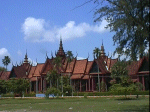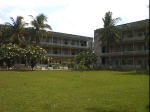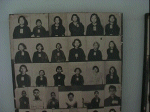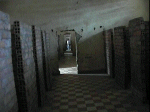The National Museum and The Ponhea Yat High School
Created | Updated Jun 21, 2003
The National Museum is situated to the side of the Royal Palace Complex between 178 Street and 184 Street. It is an impressive red building of traditional design with an arching tiled roof.

As with many public buildings it is open from 8am to 11am and 2pm to 5pm; I would advise visitors to get there early as it gets very hot and fans are few and far between. Entrance costs $2 and is well worth it. Guides congregate around the entrance, but, as usual, I opted to just look around myself.
The plan of the museum is one of four long galleries enclosing a courtyard of lilly ponds and a central pagoda with a seated Buddah. The museum was recently renovated with the help of the Australian Government and so was quite pleasant to wander around.
The majority of the exhibits are statues, either bronze or sandstone; and the majority come from the Siem Reap area. Some of the earliest statues date back to the sixth and seventh centuries (particularly noteworthy was the exhibition of statues of elephant headed Ganesa). The most delicate and ethereal carving, however, date from the end of the Chenla period and the early part of the Angkor period (approximately eighth century through to the fourteenth century). For me the statue of Jayavarman VII (around 1181 - 1218) was the most impressive, and could stand up against anything produced either in Classical Greece or in modern times.
There was also an exhibit of more modern (eighteenth and nineteenth century) artifacts, carved bowls, drinking vessels etc. but, to me, they couldn't hold a candle to the statues.
Built in 1962 as the Ponhea Yat High School, it was named after an ancestor of King Norodom Sihanouk. In the 1970's the school's name was changed by the US backed Republican regime to Tuol Svay Prey High School (named after the sub-district in the south of Phnom Penh in which it is found).
After Phnom Penh had been emptied by the Khmer Rouge, the school was set up as Security Office 21, or S-21. It was also given the name Tuol Sleng which can be literally translated as either a poisonous hill or a place on a mound to keep those who bear guilt.
From the outside the building looks like any other school building, similar in construction to many of the schools I have visited in Africa, the Caribbean and Asia.
It was easy to picture students leaning on the balconies or sitting in groups on the grass. Moving closer, the horror of the place was obvious. Nearing the first building one sees fourteen graves. When the prison was liberated by the Vietnamese in early 1979, seven inmates were found alive, another fourteen had been murdered as the guards left. They were buried on site. The ground floor of Building A is a series of rooms, each with a bare metal bedstead fixed in the centre. A variety of metal bars, shackles and weapons such as hoes are laid out on the beds. On each wall is a large photograph of how the room was found, on each bed the twisted corpse of one of the fourteen.
Each of the rooms on the ground floor of Building B is connected to the next with a hole knocked through the walls. The walls of each room are covered with photographs. The Khmer Rouge were meticulous in keeping photographic records of their victims, some taken both before and after torture. These photos have been put together in grim collages cataloguing the crimes.
Virtually all of those pictured were killed.
The victims were taken from all walks of life and from all parts of the country. The vast majority were Cambodians, but there were also prisoners of other nationalities. Apart from the prisoners, whatever their imagined crime, their families, from new-born babies to the old and infirm, were rounded up and exterminated en masse. Most were shipped out of Phnom Penh to the Killing Fields to be killed; those who died on the grounds were buried there in mass graves.
In total, some 17,000 men, women, and children passed through S-21. At its height, in 1977 and 1978, the prison held between 1,200 and 1,500 prisoners at any one time. Most prisoners were held from two to four months, although some important political prisoners were held for up to six or seven months.
Many of the torturers and executioners were children, brainwashed into believing in the Khmer Rouge revolution. However, being part of the machinery was no guarantee of safety and many of the children ended their lives as victims of the next generation of jailers.
Building C shows the types of cell. The ground floor, knocked through into a line of connected rooms, is made up of tiny roughly built brick cells.
The second floor has wooden cells, while the third floor was used to house the majority of prisoners, fourty or fifty to a room. The front of each of the balconies was covered with a grid of barbed wire to prevent suicides.
The final building, Building D, houses more photographs, along with instruments of torture, defaced busts of Pol Pot, and paintings of how the various torture methods were carried out. The final room contains a map of Cambodia made from the bones of the victims.
A grisly reminder that, while S-21 was the centre, the effects were felt all over the country.
Stepping out into the sunlight and the fresh air I wondered why I, or any tourist, should inflict this place upon themselves. But I realised that, if nothing else, the victims of this evil place deserve to be remembered. I also believe that museums like S-21, and others like it around the world, may help in some small way to prevent the terror from being repeated.




